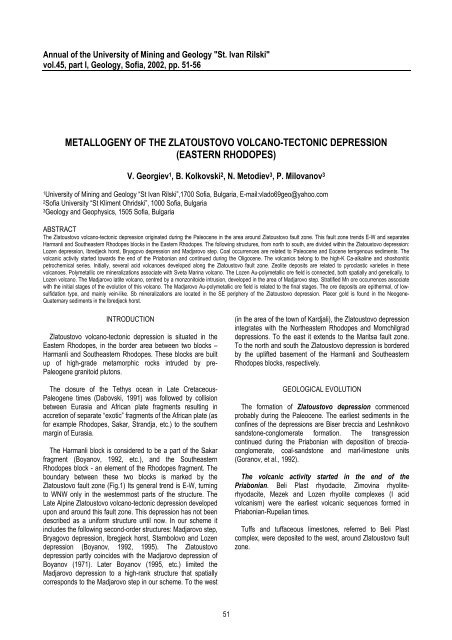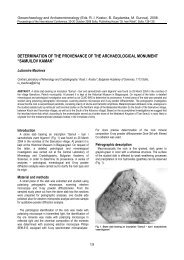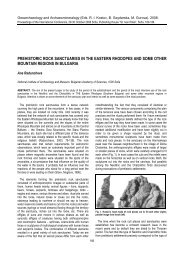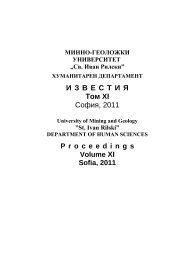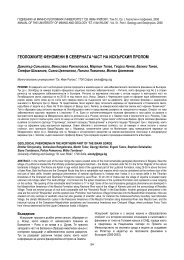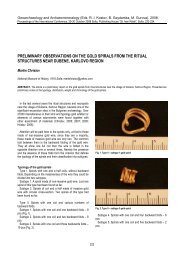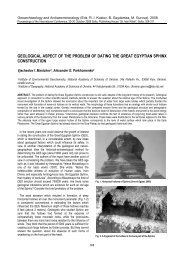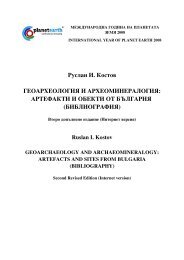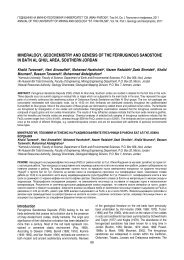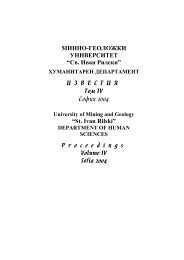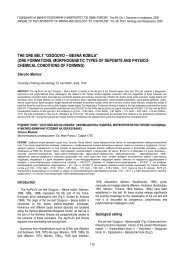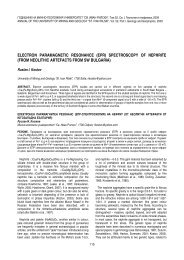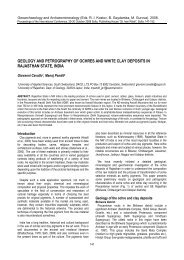metallogeny of the zlatoustovo volcano-tectonic depression
metallogeny of the zlatoustovo volcano-tectonic depression
metallogeny of the zlatoustovo volcano-tectonic depression
You also want an ePaper? Increase the reach of your titles
YUMPU automatically turns print PDFs into web optimized ePapers that Google loves.
Annual <strong>of</strong> <strong>the</strong> University <strong>of</strong> Mining and Geology "St. Ivan Rilski"<br />
vol.45, part I, Geology, S<strong>of</strong>ia, 2002, pp. 51-56<br />
METALLOGENY OF THE ZLATOUSTOVO VOLCANO-TECTONIC DEPRESSION<br />
(EASTERN RHODOPES)<br />
V. Georgiev 1 , B. Kolkovski 2 , N. Metodiev 3 , P. Milovanov 3<br />
1 University <strong>of</strong> Mining and Geology “St Ivan Rilski”,1700 S<strong>of</strong>ia, Bulgaria, E-mail:vlado69geo@yahoo.com<br />
2 S<strong>of</strong>ia University “St Kliment Ohridski”, 1000 S<strong>of</strong>ia, Bulgaria<br />
3 Geology and Geophysics, 1505 S<strong>of</strong>ia, Bulgaria<br />
ABSTRACT<br />
The Zlatoustovo <strong>volcano</strong>-<strong>tectonic</strong> <strong>depression</strong> originated during <strong>the</strong> Paleocene in <strong>the</strong> area around Zlatoustovo fault zone. This fault zone trends E-W and separates<br />
Harmanli and Sou<strong>the</strong>astern Rhodopes blocks in <strong>the</strong> Eastern Rhodopes. The following structures, from north to south, are divided within <strong>the</strong> Zlatoustovo <strong>depression</strong>:<br />
Lozen <strong>depression</strong>, Ibredjeck horst, Bryagovo <strong>depression</strong> and Madjarovo step. Coal occurrences are related to Paleocene and Eocene terrigenous sediments. The<br />
volcanic activity started towards <strong>the</strong> end <strong>of</strong> <strong>the</strong> Priabonian and continued during <strong>the</strong> Oligocene. The volcanics belong to <strong>the</strong> high-K Ca-alkaline and shoshonitic<br />
petrochemical series. Initially, several acid <strong>volcano</strong>es developed along <strong>the</strong> Zlatoustovo fault zone. Zeolite deposits are related to pyroclastic varieties in <strong>the</strong>se<br />
<strong>volcano</strong>es. Polymetallic ore mineralizations associate with Sveta Marina <strong>volcano</strong>. The Lozen Au-polymetallic ore field is connected, both spatially and genetically, to<br />
Lozen <strong>volcano</strong>. The Madjarovo latite <strong>volcano</strong>, centred by a monzonitoide intrusion, developed in <strong>the</strong> area <strong>of</strong> Madjarovo step. Stratified Mn ore occurrences associate<br />
with <strong>the</strong> initial stages <strong>of</strong> <strong>the</strong> evolution <strong>of</strong> this <strong>volcano</strong>. The Madjarovo Au-polymetallic ore field is related to <strong>the</strong> final stages. The ore deposits are epi<strong>the</strong>rmal, <strong>of</strong> lowsulfidation<br />
type, and mainly vein-like. Sb mineralizations are located in <strong>the</strong> SE periphery <strong>of</strong> <strong>the</strong> Zlatoustovo <strong>depression</strong>. Placer gold is found in <strong>the</strong> Neogene-<br />
Quaternary sediments in <strong>the</strong> Ibredjeck horst.<br />
INTRODUCTION<br />
Zlatoustovo <strong>volcano</strong>-<strong>tectonic</strong> <strong>depression</strong> is situated in <strong>the</strong><br />
Eastern Rhodopes, in <strong>the</strong> border area between two blocks –<br />
Harmanli and Sou<strong>the</strong>astern Rhodopes. These blocks are built<br />
up <strong>of</strong> high-grade metamorphic rocks intruded by pre-<br />
Paleogene granitoid plutons.<br />
The closure <strong>of</strong> <strong>the</strong> Tethys ocean in Late Cretaceous-<br />
Paleogene times (Dabovski, 1991) was followed by collision<br />
between Eurasia and African plate fragments resulting in<br />
accretion <strong>of</strong> separate “exotic” fragments <strong>of</strong> <strong>the</strong> African plate (as<br />
for example Rhodopes, Sakar, Strandja, etc.) to <strong>the</strong> sou<strong>the</strong>rn<br />
margin <strong>of</strong> Eurasia.<br />
The Harmanli block is considered to be a part <strong>of</strong> <strong>the</strong> Sakar<br />
fragment (Boyanov, 1992, etc.), and <strong>the</strong> Sou<strong>the</strong>astern<br />
Rhodopes block - an element <strong>of</strong> <strong>the</strong> Rhodopes fragment. The<br />
boundary between <strong>the</strong>se two blocks is marked by <strong>the</strong><br />
Zlatoustovo fault zone (Fig.1) Its general trend is E-W, turning<br />
to WNW only in <strong>the</strong> westernmost parts <strong>of</strong> <strong>the</strong> structure. The<br />
Late Alpine Zlatoustovo <strong>volcano</strong>-<strong>tectonic</strong> <strong>depression</strong> developed<br />
upon and around this fault zone. This <strong>depression</strong> has not been<br />
described as a uniform structure until now. In our scheme it<br />
includes <strong>the</strong> following second-order structures: Madjarovo step,<br />
Bryagovo <strong>depression</strong>, Ibregjeck horst, Stambolovo and Lozen<br />
<strong>depression</strong> (Boyanov, 1992, 1995). The Zlatoustovo<br />
<strong>depression</strong> partly coincides with <strong>the</strong> Madjarovo <strong>depression</strong> <strong>of</strong><br />
Boyanov (1971). Later Boyanov (1995, etc.) limited <strong>the</strong><br />
Madjarovo <strong>depression</strong> to a high-rank structure that spatially<br />
corresponds to <strong>the</strong> Madjarovo step in our scheme. To <strong>the</strong> west<br />
51<br />
(in <strong>the</strong> area <strong>of</strong> <strong>the</strong> town <strong>of</strong> Kardjali), <strong>the</strong> Zlatoustovo <strong>depression</strong><br />
integrates with <strong>the</strong> Nor<strong>the</strong>astern Rhodopes and Momchilgrad<br />
<strong>depression</strong>s. To <strong>the</strong> east it extends to <strong>the</strong> Maritsa fault zone.<br />
To <strong>the</strong> north and south <strong>the</strong> Zlatoustovo <strong>depression</strong> is bordered<br />
by <strong>the</strong> uplifted basement <strong>of</strong> <strong>the</strong> Harmanli and Sou<strong>the</strong>astern<br />
Rhodopes blocks, respectively.<br />
GEOLOGICAL EVOLUTION<br />
The formation <strong>of</strong> Zlatoustovo <strong>depression</strong> commenced<br />
probably during <strong>the</strong> Paleocene. The earliest sediments in <strong>the</strong><br />
confines <strong>of</strong> <strong>the</strong> <strong>depression</strong>s are Biser breccia and Leshnikovo<br />
sandstone-conglomerate formation. The transgression<br />
continued during <strong>the</strong> Priabonian with deposition <strong>of</strong> brecciaconglomerate,<br />
coal-sandstone and marl-limestone units<br />
(Goranov, et al., 1992).<br />
The volcanic activity started in <strong>the</strong> end <strong>of</strong> <strong>the</strong><br />
Priabonian. Beli Plast rhyodacite, Zimovina rhyoliterhyodacite,<br />
Mezek and Lozen rhyolite complexes (I acid<br />
volcanism) were <strong>the</strong> earliest volcanic sequences formed in<br />
Priabonian-Rupelian times.<br />
Tuffs and tuffaceous limestones, referred to Beli Plast<br />
complex, were deposited to <strong>the</strong> west, around Zlatoustovo fault<br />
zone.
Figure 1. Generalised geological map <strong>of</strong> <strong>the</strong> Eastern Rhodopes (after Iovtchev et al., 1971, modified). 1 - Central Rhodopes block;<br />
2 - Harmanli block; 3 - Sou<strong>the</strong>astern Rhodopes block; 4 - Sakar block; 1a, 2a, 3a, 4a - surface exposures <strong>of</strong> <strong>the</strong> basement <strong>of</strong> <strong>the</strong><br />
respective blocks; 5 - Paleogene sediments and volcanics; 6 - Neogene-Quaternary deposits; 7 - boundaries <strong>of</strong> <strong>the</strong> studied area1;<br />
8 - Maritsa fault zone; 9 - Pchelarovo fault set; 10 - Ardino fault; 11 - Zlatoustovo fault zone.<br />
Lyaskovets <strong>volcano</strong>, comprising <strong>the</strong> rocks <strong>of</strong> Zimovina<br />
complex, was formed in <strong>the</strong> westernmost parts <strong>of</strong> <strong>the</strong><br />
Zlatoustovo <strong>depression</strong>.<br />
Mezek complex is located in <strong>the</strong> easternmost parts <strong>of</strong> <strong>the</strong><br />
Ibredjeck horst where toge<strong>the</strong>r with acid tuffs some extrusive<br />
bodies were also formed.<br />
The effusive rocks <strong>of</strong> Lozen complex build up Sveta Marina<br />
<strong>volcano</strong> in <strong>the</strong> Ibredjeck horst as well as Lozen <strong>volcano</strong><br />
(Yanev, et al., 1975) situated within <strong>the</strong> Lozen <strong>depression</strong>.<br />
52<br />
Silen <strong>volcano</strong>, composed <strong>of</strong> <strong>the</strong> rhyolites <strong>of</strong> Perperek<br />
complex (II acid volcanism), is located in <strong>the</strong> western parts <strong>of</strong><br />
Zlatoustovo <strong>depression</strong>. Some later phases <strong>of</strong> this <strong>volcano</strong> are<br />
established in <strong>the</strong> area <strong>of</strong> Lozen <strong>volcano</strong>. These are Cherna<br />
Mogila trachyrhyodacite and Planinets trachyrhyolite<br />
complexes (II and III acid volcanism) as well as some dioriteporphyrite<br />
bodies <strong>of</strong> Cherna Mogila complex that intrude <strong>the</strong><br />
rocks <strong>of</strong> Lozen <strong>volcano</strong>.
Madjarovo <strong>volcano</strong> is located in <strong>the</strong> sou<strong>the</strong>rn parts <strong>of</strong> <strong>the</strong><br />
<strong>depression</strong>. It is formed <strong>of</strong> <strong>the</strong> rocks <strong>of</strong> Madjarovo latite<br />
complex (II intermediate volcanism). Intermediate tuffs, tuffites,<br />
and tuff-breccias interbedded with reef limestones were<br />
deposited during <strong>the</strong> earliest stages. Later followed eruptions<br />
<strong>of</strong> trachybasaltic andesites, various latites, trachydacites and<br />
quartz-trachytes. They form an elliptic volcanic edifice (17x11<br />
km) elongated in WNW direction (Fig. 2). This large <strong>volcano</strong><br />
associates with numerous smaller satellite and parasitic<br />
volcanic cones. In <strong>the</strong> vicinity <strong>of</strong> <strong>the</strong> town <strong>of</strong> Madjarovo, few<br />
relatively small intrusive bodies are also found (Mavrudchiev,<br />
1959). They are probably parts <strong>of</strong> a larger intrusion, emplaced<br />
in <strong>the</strong> main magma conduit that fed <strong>the</strong> Madjarovo <strong>volcano</strong>.<br />
The volcanic cone is cut by numerous dykes <strong>of</strong> trachybasalticandesite,<br />
latiteandesite and latite compositions. Most <strong>of</strong> <strong>the</strong>m<br />
are radial, but some are randomly oriented.<br />
Valche Pole unit (<strong>of</strong> Oligocene-Miocene age) was deposited<br />
within <strong>the</strong> Bryagovo <strong>depression</strong>, and Ahmatovo Formation<br />
(Miocene-Pliocene) - in <strong>the</strong> Lozen <strong>depression</strong>.<br />
METALLOGENY<br />
Volcano-sedimentary zeolite deposits are related to <strong>the</strong><br />
tuffs <strong>of</strong> <strong>the</strong> Beli Plast rhyodacite and, to a lesser extent, to <strong>the</strong><br />
tuffs <strong>of</strong> <strong>the</strong> Mezek and Perperek rhyolite complexes. The<br />
zeolite-bearing bodies are stratum- or lens-like. These<br />
deposits, as well as <strong>the</strong> hosting tuffs, are located around <strong>the</strong><br />
Zlatoustovo fault zone. In <strong>the</strong> western part <strong>of</strong> <strong>the</strong> <strong>depression</strong>,<br />
<strong>the</strong>re are deposits <strong>of</strong> clinoptilolite (associated with chlorite,<br />
celadonite and montmorillonite) related to <strong>the</strong> pyroclastics <strong>of</strong><br />
Beli Plast (Most and Rabovo deposits) and Perperek (Perperek<br />
deposit) complexes. In <strong>the</strong> area <strong>of</strong> Lyaskovets village, <strong>the</strong> tuffs<br />
<strong>of</strong> <strong>the</strong> Beli Plast complex are mordenitized and contain<br />
analcime and clinoptilolite (Djourova and Aleksiev, 1988).<br />
Mordenite-clinoptilolite zeolites, accompanied by erionite,<br />
analcime and stilbite, occur in acid tuffs <strong>of</strong> <strong>the</strong> Mezek complex<br />
in <strong>the</strong> eastern parts <strong>of</strong> <strong>the</strong> Ibredjeck horst (Ivanova, et al.,<br />
2001).<br />
Sveta Marina lead-zinc deposit is closely associated with<br />
<strong>the</strong> <strong>volcano</strong> <strong>of</strong> <strong>the</strong> same name. The ore mineralizations form<br />
stratum- or lens-like bodies within <strong>the</strong> Priabonian sediments.<br />
The following stages <strong>of</strong> mineralization are recognised on <strong>the</strong><br />
basis <strong>of</strong> <strong>the</strong> most important minerals (Breskovska and<br />
Gergelchev, 1988): 1) quartz-galena-sphalerite with minor<br />
pyrite and chalcopyrite; 2) quartz-barite-sulfosalts (with<br />
restricted distribution) – <strong>the</strong> sulfosalts are tetrahedrite and<br />
tennantite; 3) carbonate (also locally present) - calcite,<br />
dolomite. The authors, cited above, described also a stage <strong>of</strong><br />
later sulfosalts, but <strong>the</strong>y are represented by separate pyrite,<br />
galena and sphalerite crystals over carbonates and probably<br />
belong to <strong>the</strong> carbonate stage.<br />
The Lozen lead-zinc ore field is related, spatially and<br />
genetically, to <strong>the</strong> Lozen rhyolite <strong>volcano</strong>. According to<br />
Breskovska and Gergelchev (1988), <strong>the</strong> ore bodies are <strong>of</strong> two<br />
Georgiev V. et al. METALLOGENY OF THE ZLATOUSTOVO VOLCANO-TECTONIC …<br />
types: shallowly dipping veinlet-disseminated ore<br />
mineralizations interbedded with sediments and volcanics; and<br />
fault-hosted steeply dipping vein-like bodies <strong>of</strong> veinletdisseminated<br />
and vein type ore mineralizations. The orehosting<br />
rocks were affected by intensive hydro<strong>the</strong>rmal<br />
alteration prior to <strong>the</strong> ore mineralization. The alteration in <strong>the</strong><br />
upper parts <strong>of</strong> deposits is argillization (mainly montmorillonite),<br />
and in <strong>the</strong> lower levels it is <strong>of</strong> quartz-sericite type.<br />
According to Breskovska and Gergelchev (1988), <strong>the</strong> ore<br />
mineralization was formed in three stages: 1) quartz-galenasphalerite<br />
(or quartz-sulphide) – <strong>the</strong> productive stage, with<br />
pyrite and chalcopyrite as subordinate minerals; 2) quartzbarite<br />
with gold (<strong>of</strong> restricted distribution); and 3) carbonate<br />
(calcite, dolomite, ankerite) stage. According to Bogdanov<br />
(1983) <strong>the</strong> barite mineralization is later than <strong>the</strong> carbonate one.<br />
Concentric horizontal zonality in <strong>the</strong> spatial distribution <strong>of</strong> ore<br />
mineralization was described (Bogdanov, 1983): Cu-Pb-Zn<br />
mineralizations concentrate in <strong>the</strong> outermost parts, Pb-Zn – in<br />
<strong>the</strong> middle and Au-Ag mineralizations - in <strong>the</strong> outermost parts<br />
<strong>of</strong> <strong>the</strong> deposit.<br />
Madjarovo polymetallic and gold-polymetallic ore field.<br />
Veinlet-disseminated type copper-molybdenum mineralization<br />
<strong>of</strong> non-economic significance occurs within <strong>the</strong> monzonitoid<br />
bodies in Madjarovo <strong>volcano</strong>.<br />
Polymetallic and gold-polymetallic ores are localized mainly<br />
in <strong>the</strong> inner (central) parts <strong>of</strong> <strong>the</strong> <strong>volcano</strong> (Gorno Pole, Arda,<br />
Momina Skala, Patronkaya, Gaberovo, Radonovsko,<br />
Harmankaya, Chatalkaya and Brusevtsi deposits). The ore<br />
bodies are <strong>of</strong> vein type, steeply dipping (70-90 o ) and most <strong>of</strong><br />
<strong>the</strong>m are radial with respect to <strong>the</strong> Madjarovo <strong>volcano</strong>. They<br />
are located mainly within <strong>the</strong> volcanics and locally - in <strong>the</strong><br />
sedimentary and metamorphic rocks from <strong>the</strong> basement <strong>of</strong> <strong>the</strong><br />
<strong>volcano</strong>. Small metasomatic bodies are hosted in limestones.<br />
The host rocks <strong>of</strong> <strong>the</strong> ore field rocks are affected by three<br />
temporal types <strong>of</strong> hydro<strong>the</strong>rmal alterations: early pre-ore, preore,<br />
and syn-ore. The first type is a regional propylitization <strong>of</strong><br />
<strong>the</strong> volcanic rocks. Secondary quarzites (advanced argillizites)<br />
are also related to <strong>the</strong> first type. They form concentric zones<br />
around monzonitoid intrusions: <strong>the</strong> alterations in <strong>the</strong> inner parts<br />
are <strong>of</strong> argillizite type, propylites are established in <strong>the</strong><br />
peripheries and <strong>the</strong> most intensively altered parts are<br />
converted to diaspor-bearing alunite-quartzites and zunyitbearing<br />
diaspor-quartzites. Pre-ore metasomatics are<br />
restricted along faults and belong to <strong>the</strong> adularia-sericite type<br />
(Velinov and Nokov, 1991). The syn-ore alteration is<br />
represented by sporadic kaolinization and is poorly studied.<br />
Various in number and composition stages <strong>of</strong> ore<br />
mineralization have been distinguished by different authors<br />
(Radonova, 1960; Atanasov, 1962; Kolkovski, 1971;<br />
Breskovska and Gergelchev, 1988). Our studies suggest five<br />
mineralization stages: 1) specularite-guartz with gold<br />
(productive for Au); 2) quartz-chalcopyrite (also productive for<br />
Au); 3) quartz-galena-sphalerite with pyrite and chalcopyrite as<br />
ANNUAL University <strong>of</strong> Mining and Geology “St. Ivan Rilski”, vol. 45 (2002), part I G E O L O G Y<br />
53
Georgiev V. et al. METALLOGENY OF THE ZLATOUSTOVO VOLCANO-TECTONIC …<br />
Figure 2.. Metallogenic map <strong>of</strong> <strong>the</strong> Zlatustovo <strong>volcano</strong>-<strong>tectonic</strong> <strong>depression</strong>. Quaternary: 1- alluvium; 2- proluvium; Miocene-<br />
Pliocene: 3-Ahmatovo Formation; Oligocene-Miocene: 4-Valche Pole Formation; Oligocene: 5- Planinets trachyrhyolite complex; 6-<br />
Cherna Mogila trachyrhyodacite complex; 7-Perperek rhyolite complex: 7a- rhyolite; 7b- tuffs; 8-Madjarovo latite complex; Eocene-<br />
Oligocene: 9-Lozen rhyolite complex: 9a- rhyolite; 9b- tuffs; 10-Mezek rhyolite complex: 10a- rhyolite; 10b- tuffs; 11-Beli Plast<br />
rhyodacite complex - tuffs; 12- Zimovina rhyolite complex; Paleocen- Eocene: 13-Paleogene sedimentary complexes; 14-pre-<br />
Paleogene basement; Ore deposits: 15- Zeolite; 16- Polymetallic (Pb-Zn); 17- Gold-polymetallic; 18- Manganese (pyrolusite); 19-<br />
Antimony; 20-Wea<strong>the</strong>ring deposits (halloysite-kaolinite, kaolinite, psilomelane-pyrolusite); 21-Placer gold; 22-Volcanic cone <strong>of</strong> <strong>the</strong><br />
Madjarovo <strong>volcano</strong>; 23-extrusive bodies; 24- fault; 25- Zlatoustovo fault zone; MV -Madjarovo <strong>volcano</strong>; LV -Liaskovo <strong>volcano</strong>; SV -<br />
Silen <strong>volcano</strong>; SMV - Sveta Marina <strong>volcano</strong>; MZV - Mezek <strong>volcano</strong>; LZV - Lozen <strong>volcano</strong> Placer gold is found both to <strong>the</strong> north and<br />
south <strong>of</strong> <strong>the</strong> Ibredjeck horst, in <strong>the</strong> areas <strong>of</strong> <strong>the</strong> villages <strong>of</strong> Tankovo, Zlatoustovo, Efrem, etc., and within <strong>the</strong> Lozen <strong>depression</strong>. They<br />
might have resulted from <strong>the</strong> destruction <strong>of</strong> <strong>the</strong> coarse-grained sediments that build up a large part <strong>of</strong> <strong>the</strong> horst. Au-bearing placers<br />
are identified along Bryagovska River and <strong>the</strong>y could have formed at <strong>the</strong> expense <strong>of</strong> <strong>the</strong> gold dispersed in <strong>the</strong> metamorphic rocks<br />
exposed near by. Non <strong>of</strong> <strong>the</strong>se occurrences is <strong>of</strong> economic significance.<br />
subordinate minerals (productive for Pb, Zn, and to some<br />
extent for Cu, Ag, and Au); 4) quartz-chalcedony-barite with<br />
ANNUAL University <strong>of</strong> Mining and Geology “St. Ivan Rilski”, vol. 45 (2002), part I G E O L O G Y<br />
54<br />
Ag-sulfosalts and electrum (productive for Au); and 5)<br />
carbonate-quartz (locally present). In <strong>the</strong> surface parts <strong>of</strong> <strong>the</strong>
ore field, <strong>the</strong> hydro<strong>the</strong>rmal solutions produced minerals, typical<br />
<strong>of</strong> supergenic conditions (chalcophanite, wavellite and<br />
anglesite). This was probably caused by mixing <strong>of</strong><br />
hydro<strong>the</strong>rmal and rich in oxygen meteoric solutions.<br />
A dome-like zonality in <strong>the</strong> distribution <strong>of</strong> ore mineralizations<br />
has been described around <strong>the</strong> main magmatic and orecontrolling<br />
structure - <strong>the</strong> vent <strong>of</strong> <strong>the</strong> Madjarovo <strong>volcano</strong> (Iliev,<br />
1980). The predominating ore mineralizations in <strong>the</strong> inner and<br />
lower parts <strong>of</strong> <strong>the</strong> ore field are Pb-Zn, while Au-bearing<br />
dominate in <strong>the</strong> upper and peripheral parts <strong>of</strong> <strong>the</strong> deposit<br />
Madjarovo ore field is related both spatially and genetically<br />
to <strong>the</strong> Madjarovo <strong>volcano</strong>. They have a common source in<br />
depth and both result from <strong>the</strong> evolution <strong>of</strong> one magma<br />
chamber.<br />
Manganese (pyrolusite) ore occurrences (Borislavtsi and<br />
Kochash) form beds or networks <strong>of</strong> tiny veinlets in lava flows<br />
on <strong>the</strong> slopes <strong>of</strong> Madjarovo <strong>volcano</strong>. The gold-polymetallic<br />
Madjarovo ore field is also associated with this large <strong>volcano</strong>.<br />
The ore mineralizations are epi<strong>the</strong>rmal, <strong>of</strong> low-sulfidation type.<br />
The Mareshnitsa antimony occurrence is situated to <strong>the</strong><br />
sou<strong>the</strong>ast <strong>of</strong> <strong>the</strong> Madjarovo <strong>volcano</strong>. It is hosted in brecciaconglomerates<br />
<strong>of</strong> <strong>the</strong> Krumovgrad Group. The ore<br />
mineralization consists <strong>of</strong> quartz and stibnite as well as minor<br />
calcite, realgar, pyrite and pyrrhotite (Mladenova and LŸders,<br />
2000). This mineralization, as usual in <strong>the</strong> Eastern Rhodopes,<br />
is located in <strong>the</strong> periphery <strong>of</strong> <strong>the</strong> <strong>depression</strong>. Its connection<br />
with <strong>the</strong> volcanism in not so clear and is, to a certain extent,<br />
hypo<strong>the</strong>tical. As a more low-temperature mineralization, it<br />
seems to be formed at a greater distance from <strong>the</strong> volcanic<br />
edifices.<br />
The halloysite-kaolinite deposit <strong>of</strong> Dolni-Glavanak, as well<br />
as some occurrences <strong>of</strong> this type (Topolovo, Topolovo-E and<br />
Borislavtsi) are related to wea<strong>the</strong>ring crusts formed upon <strong>the</strong><br />
nor<strong>the</strong>rn periphery <strong>of</strong> <strong>the</strong> Madjarovo <strong>volcano</strong> (Todorova, 1988).<br />
In <strong>the</strong> wea<strong>the</strong>ring zone <strong>of</strong> <strong>the</strong> tuffs <strong>of</strong> Perperek complex,<br />
kaolinite and psilomelane-pyrolusite mineralizations were<br />
formed. All <strong>of</strong> <strong>the</strong>m are covered by sediments <strong>of</strong> <strong>the</strong> Valche<br />
Pole unit which contains coal occurrences.<br />
CONCLUDING REMARKS<br />
The cyclic evolution <strong>of</strong> <strong>the</strong> volcanism in <strong>the</strong> Eastern<br />
Rhodopes, that is believed to be a four-fold alternation <strong>of</strong><br />
intermediate and acid phases (Ivanov, 1960, 1963; Harkovska,<br />
et al., 1989, etc.), is an idealised and abstract scheme. In fact,<br />
<strong>the</strong> magmatic activity usually evolved from intermediate to acid<br />
in <strong>the</strong> individual volcanic edifices. Several magmatic chambers<br />
with similar, but not contemporaneous development might have<br />
existed. Their activities overlapped in space and time and that<br />
is why <strong>the</strong>ir products at <strong>the</strong> surface overprint and interfinger<br />
laterally, creating <strong>the</strong> impression <strong>of</strong> a cyclic evolution. Thus, <strong>the</strong><br />
idea <strong>of</strong> <strong>the</strong> existence <strong>of</strong> several alternating phases (I, II, etc.) <strong>of</strong><br />
intermediate and acid volcanism is used here for <strong>the</strong> readers’<br />
convenience.<br />
Georgiev V. et al. METALLOGENY OF THE ZLATOUSTOVO VOLCANO-TECTONIC …<br />
Only acid volcanism belonging to different phases occurred<br />
around <strong>the</strong> Zlatoustovo fault zone and in <strong>the</strong> nor<strong>the</strong>rn parts <strong>of</strong><br />
<strong>the</strong> Zlatoustovo <strong>depression</strong> where mainly zeolite deposits are<br />
localized. There, polymetallic ore mineralizations are <strong>of</strong><br />
subordinate significance and <strong>the</strong>ir association with acid<br />
volcanics is a quite unusual case in nature. Mainly intermediate<br />
volcanism developed in <strong>the</strong> sou<strong>the</strong>rn parts <strong>of</strong> <strong>the</strong> <strong>depression</strong><br />
where Madjarovo Au-polymetallic ore field and some Mn<br />
mineralizations associate with <strong>the</strong> Madjarovo <strong>volcano</strong>. Sb<br />
mineralizations are also identified.<br />
REFERENCES<br />
Atanasov, A., 1962. Mineralization stages, primary zoning and<br />
genesis <strong>of</strong> <strong>the</strong> complex ore-deposit <strong>of</strong> Madjarovo. - Ann.<br />
Univ. S<strong>of</strong>ia, Geol.-Geogr. Fac., 55, 2 (in Bulgarian with an<br />
English abstract), 229-267.<br />
Bogdanov, K., 1983. Endogene zonality in <strong>the</strong> Lozen Ore Field,<br />
Eastern Rhodope Mountains. - Ore-form. Proc. and Miner.<br />
Dep., 18 (in Bulgarian with an English abstract), 48-60.<br />
Boyanov, I., 1971. Young Paleogene and Neogene<br />
<strong>depression</strong>s superimposed on <strong>the</strong> East Rhodope Block. -<br />
S<strong>of</strong>ia, “Tectonic structure <strong>of</strong> Bulgaria” (in Bulgarian),<br />
Tehnika, 127-135.<br />
Boyanov I., 1992. Tectonics. - Explanatory note to <strong>the</strong><br />
geological map <strong>of</strong> Bulgaria on scale: 1:100 000; Haskovo<br />
map sheet. Com. Geol. and Min. Res. (in Bulgarian), 69-<br />
78.<br />
Boyanov I., 1995. Tectonics. - Explanatory note to <strong>the</strong><br />
geological map <strong>of</strong> Bulgaria on scale: 1:100 000;<br />
Krumovgrad and Sape map sheet. Com. Geol. and Min.<br />
Res. (in Bulgarian), 69-78.<br />
Breskovska, V., Gergelchev, V., 1988. Lozen Ore Field. -<br />
S<strong>of</strong>ia, “The lead-zinc deposits in Bulgaria” (in Bulgarian)<br />
Tehnika, 127-133.<br />
Breskovska, V., Gergelchev, V., 1988. Madjarovo Ore Field. -<br />
S<strong>of</strong>ia, “The lead-zinc deposits in Bulgaria” (in Bulgarian),<br />
Tehnika, 114-126<br />
Goranov, A., Boyanov, I., Atanasov, G., 1992.<br />
Lithostratigraphic subdivision <strong>of</strong> <strong>the</strong> Paleogene and<br />
Neogene in <strong>the</strong> East Rhodopes and its correlation with <strong>the</strong><br />
Paleogene and Neogene in Upper Thracia. - Ann. Univ.<br />
S<strong>of</strong>ia, Geol.-Geogr. Fac., 82, 1 (in Bulgarian with an<br />
English abstract), 169-182.<br />
Goranov, A., Popov, S., 1989. Perlites. - S<strong>of</strong>ia, “Non-metallic<br />
mineral deposits in Bulgaria. Vol. 2” (in Bulgarian),<br />
Tehnika, 62-79.<br />
Dabovski, C., 1991. Modern concepts on <strong>the</strong> evolution <strong>of</strong> <strong>the</strong><br />
Alpine orogen in <strong>the</strong> Eastern Mediterranean and <strong>the</strong><br />
Carpathian-Balcan area. A review and some problems <strong>of</strong><br />
Bulgarian geo<strong>tectonic</strong>s. - Geotect., Tectonophys. and<br />
Geodynam., 22 (in Bulgarian with an English abstract), 45-<br />
79.<br />
Djourova, E., Aleksiev, B., 1989. Zeolitic Rocks. - S<strong>of</strong>ia, “Nonmetallic<br />
mineral deposits in Bulgaria. Vol. 1”, (in Bulgarian),<br />
Tehnika, 233-247.<br />
Harkovska, A., Y. Yanev, P. Marchev. 1989. General features<br />
<strong>of</strong> <strong>the</strong> Paleogene orogenic magmatism in Bulgaria. Geol.<br />
Balcanica., 19, 1, 37-72.<br />
ANNUAL University <strong>of</strong> Mining and Geology “St. Ivan Rilski”, vol. 45 (2002), part I G E O L O G Y<br />
55
Georgiev V. et al. METALLOGENY OF THE ZLATOUSTOVO VOLCANO-TECTONIC …<br />
Iliev, Z., 1980. Types <strong>of</strong> zoning in <strong>the</strong> Madzarovo Ore Field. -<br />
Ann. Univ. S<strong>of</strong>ia, Geol.-Geogr. Fac., 1-geol., 73, 1 (in<br />
Bulgarian with an English abstract), 79-89.<br />
Ivanov, R., 1960. Magmatism in <strong>the</strong> Eastern Rhodope<br />
Paleogene <strong>depression</strong>. Part I-Geology. - Trudove Geol.<br />
Bulg., Seria Geohim. and Polez. Izkop., 1 (in Bulgarian with<br />
a German abstract), 311-387.<br />
Ivanov, R., 1963. Magmatism in <strong>the</strong> Eastern Rhodope<br />
Paleogene <strong>depression</strong>. Part II-Petrochemical evolution and<br />
provincial peculiarities. - Trudove Geol. Bulg., Seria<br />
Geohim., Miner. and Petrogr., 4 (in Bulgarian with an<br />
English abstract), 297-323.<br />
Ivanova, R., Yanev, Y., Iliev, Tz., Koleva, E., Popova, T.,<br />
Popov, T., 2001. Mineralogy, chemistry and ion-exchange<br />
properties <strong>of</strong> <strong>the</strong> zeolitized tuffs from <strong>the</strong> Sheinovets<br />
caldera, Eastern Rhodopes (South Bulgaria). - Stud. Surf.<br />
Sci. Catal., 135, 95-103.<br />
Kolkovski, B., 1971. Hypo<strong>the</strong>sis <strong>of</strong> pulsing ore formation by<br />
example <strong>of</strong> some post-magmatic ore deposits in Bulgaria. -<br />
Geol. <strong>of</strong> Ore Dep., 13, 6 (in Russian), 44-56.<br />
Mavrudchiev, B., 1959. Upper Oligocene intrusions from <strong>the</strong><br />
Madjarovo ore district. - Ann. Univ. S<strong>of</strong>ia, Biol.-Geol.-<br />
Geogr. Fac., 52, 2-geol. (in Bulgarian with an English<br />
abstract), 251-300.<br />
Recommended for publication by Department<br />
<strong>of</strong> Economic Geology, Faculty <strong>of</strong> Geology<br />
Mladenova, V., LŸders, V., 2000. The stibnite deposits in <strong>the</strong><br />
Rhodopes, Bulgaria: Mineralogy and fluid inclusion study. -<br />
Geodynam. and Ore Deposits evolution <strong>of</strong> <strong>the</strong> Alpain-<br />
Balkan-Carpatian-Dinaride province. Abstracts. p. 53.<br />
Radonova, T., 1960. Investigations on mineral composition and<br />
hydro<strong>the</strong>rmal alterations in Madjarovo deposit, Eastern<br />
Rhodopes. - Trudove Geol. Bulg., Seria Geohim. and<br />
Polez. Izkop., 1 (in Bulgarian with a German abstract), 115-<br />
197.<br />
Todorova, T., 1988. Halloysite-kaolinite clays. - S<strong>of</strong>ia, “Nonmetallic<br />
mineral deposits in Bulgaria. Vol. 1” (in Bulgarian),<br />
Tehnika, 72-78.<br />
Velinov, I., Nokov, S., 1991. Main types and metallogenic<br />
significance <strong>of</strong> <strong>the</strong> Madjarovo hydro<strong>the</strong>rmally altered<br />
Oligocene volcanics. - C. R. Acad. bulg. Sci., 44, 9, 65-68.<br />
Yanev, Y., Harkovska, A., Mavroudchiev, B., Velchev, Ts,<br />
Nojarov, P., Damyanov, D., 1975. Lozen Paleogene<br />
<strong>volcano</strong> and its relationship with <strong>the</strong> deep structure <strong>of</strong> <strong>the</strong><br />
Eastern Rhodopes. - Geohim., Miner, and Petrol., 2 (in<br />
Russian with an English abstract), 90-101.<br />
ANNUAL University <strong>of</strong> Mining and Geology “St. Ivan Rilski”, vol. 45 (2002), part I G E O L O G Y<br />
56


